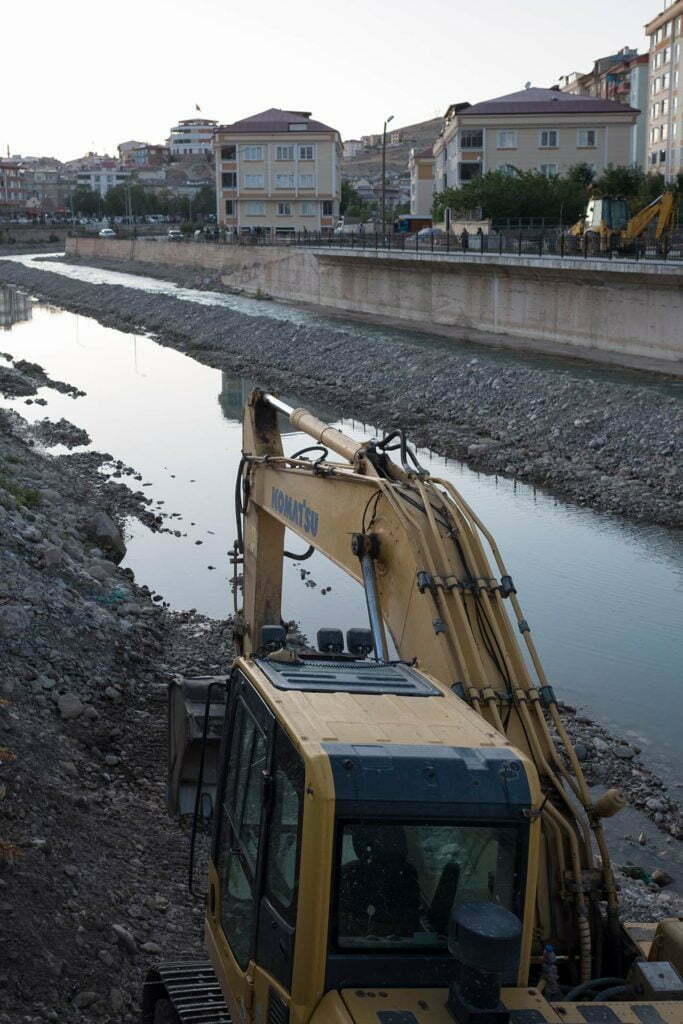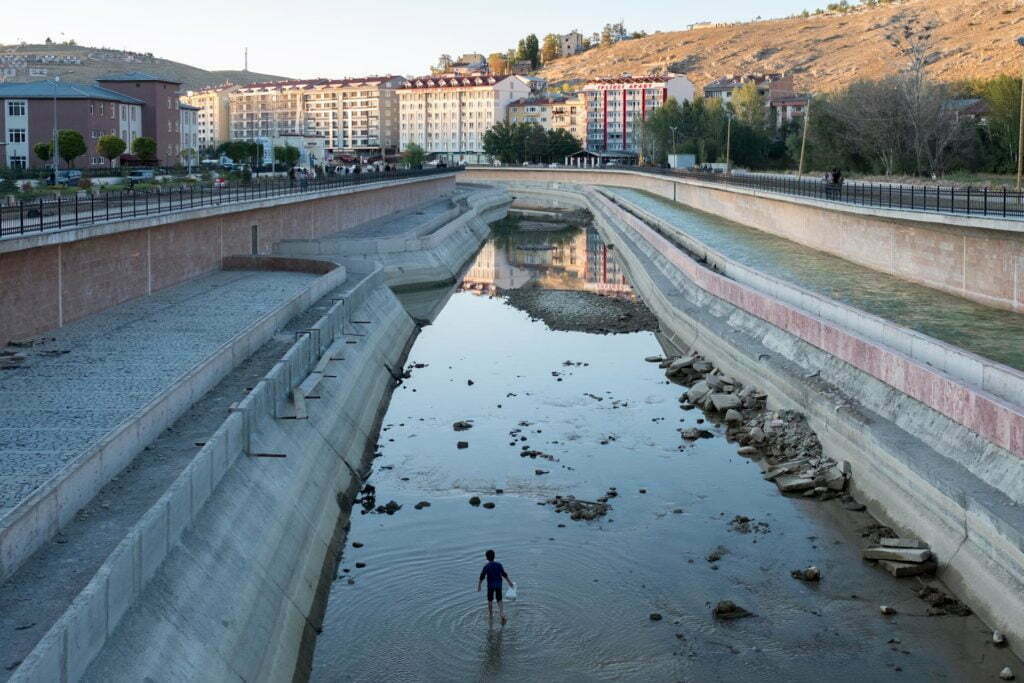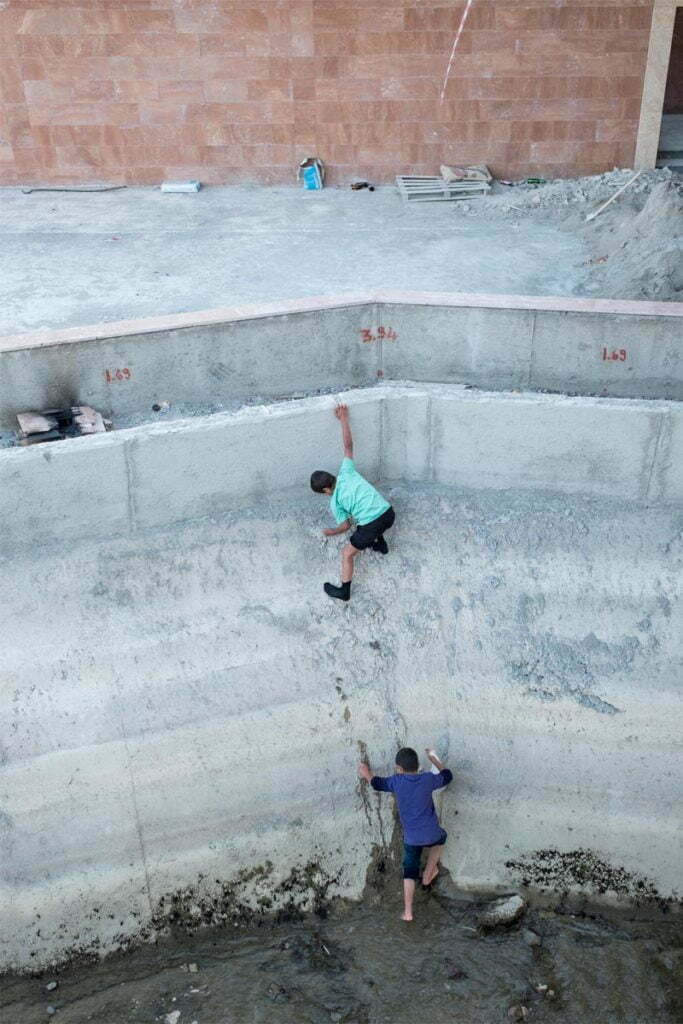AYŞE ADANALI
They drowned it. Drowning the water. They officially drowned Çoruh.

We are at the center of Bayburt. We meet Brother Hasan at the city center, over the bridge. His eyes are fixated on Çoruh. After we greet each other and before we move into small talk, the above words spill out of his mouth. It is obvious that he is in no hurry to get to know us, but he is in a hurry to talk about issues he wants us to hear and make others hear. These issues we traveled 1,125 kilometers to investigate are matters of life and death for him.
As the Center for Spatial Justice team, we cross the Çoruh River all the way with our white van. We are here to carry out our fieldwork. Our first stop is Bayburt. Most of us are here for the first time. We are investigating the “stream improvement” works carried out in the city center of Bayburt. We are looking into how the misconducted stream improvement projects destroyed Çoruh; we are trying to understand what “drowning the water” means.
Type “Bayburt” in the search engine and you will come across this sentence: Bayburt is a city in northeast Turkey, lying on the Çoruh River. As soon as you enter the city center you see, hear, and smell that the Çoruh River constitutes the identity of this place. How is it possible that, in a city lying on a river, that river is condemned to such carelessly planned and executed projects?
We walk looking around, in silence. Brother Hasan insists that we first eat something. We sit at a table on the second floor of a restaurant in the city center. Just like in many other places, we see the Çoruh River and the Bayburt Castle from where we sit.
Brother Hasan is one of the people who have been fighting against the construction of hydroelectric power plants and stream improvement projects from the start. He is the old mukhtar of the Dikmetaş village in Bayburt. He is a farmer. And he is adamant.
He says,
No need for many words. After you finish your meal, we will walk alongside Çoruh and you will see what they mean by stream improvement. There are two things that make Bayburt the city it is. One is the river, the other is the castle. The city takes its name from these things, it is famous for these things, nothing else. They drown the water and drown it in canals. These are unplanned, not very well thought or researched projects.

We are full now, and we start walking alongside the river. The area which was reconstructed within the scope of the stream improvement project looks more like an irrigation canal than a stream bed. Everyone, regardless of their familiarity level with the issue, is baffled by this view. The two sides of the river have been enclosed in concrete, the riverbed has been grossly narrowed, the ecological corridor has been removed, and the waterfront and natural vegetation have been destroyed. People’s contact with the water has been eliminated and access to the water has been made difficult.
As we walk and discuss this issue, we meet İbrahim, who is resolutely trying to catch fish. We asked him the same question: “What do you think about the stream improvement project?”
He says “improvement” and then gives a short pause. It is as if he is trying to provide us with some time to register the difference between the meaning of that word and the reality of it all:
This project… This project should be immediately stopped. They carried out some sort of landscape work but… For instance, there is the example of Eskişehir. They carried works on the riverbank of Porsuk, but they did not alter the naturalness of the river. Once you lay concrete, you alter the character of Çoruh. Above everything else, living creatures are affected.
He checks his fishing rod twice. He starts telling us anecdotes about his childhood. He is very much like other people that we met in Bayburt. He remembers his attachment to the river; he remembers the days when there were no barriers between him and the water; he tells us about the water and the creatures living in and around it. Then he continues his story talking about the current situation:
For instance, fish in the water need to find worms and other living creatures. They must find them to feed and survive. If they can no longer find them, they will disappear. The fish cannot find other creatures here, they only find concrete. Concrete. They are affected by this concrete. On top of that, there are animals that fall into the stream. Pigs fall into it, and they cannot get out. Foxes and rabbits fall in it. The concrete is in the shape of a ‘v’ and very slippery. Once they fall into it, they start skidding and cannot get out.
The river improvement works have been going on for four years now. İbrahim tells us that the locals are uneasy about the never-ending construction: “It has been four years. They stop in the summer. For some reason, they do not work in the summer. Then in the winter they come back and start again. We are in September now, in twenty days snow will start to fall and they began working only recently.”

He finishes his sentence and gives another pause, confident of himself. İbrahim, with his fish rod in his hands, points at another location on the other side.
Two kids. One of them has managed to descend into the water from a seven-meter-long concrete wall. His eyes are on his friend who is hanging on the wall. His friend is hanging down the wall, holding it only with his right hand. It is a steep wall. The child cannot find a place to put his feet with socks on them. As a team, we stand confused and anxious.
The children are so keen on reaching the water that they turn the obstacles placed in front of them into games, dangerous games. Since we heard stories about water from every adult we met, no one has the right to criticize these kids for wanting to go down to the water. Nobody criticizes them anyways. But they have many things to say to those who develop projects without considering humans and nature. We keep listening to İbrahim.
He starts to tell a story from his childhood:
When I was their age, there was a water mill there. One of those old water mills. The river disappeared. The water mill is gone. Çoruh is gone… And that childhood is gone.
As we keep on conversing, a group of people start gathering around us and we hear a voice from the group:
This place is no longer called the Çoruh River, it is a creek now. Previously it was called a river. It was the third fastest flowing river of the world, now it is a creek. A creek.
What we hear in this conversation resembles the news headlines we read when we were doing our preliminary research:
“Bayburt, Preserve the Çoruh River!”
“Bayburt Have Not Seen Such Violence in Its History.”
These headlines belong to Architect Asuman Uz. From the moment the stream improvement project became evident, she has been unrelentingly trying to explain the mistakes of the project with a scientific approach and talking about why the project should not be realized. She makes time for us without hesitation.
Bayburt is the city where she was born, raised, and started practicing her occupation. Their house was just across the river. She spent her childhood in the environs of the river. Those were the times when these places were all green and covered with trees. In 2005, the area was opened for construction even though the decision was against the legislation of the time. A building in the form of a large mass was built just next to the river. Asuman Uz’s fight begins at that point in time, and she keeps on responding at every stage:
I witnessed the beginning of the project in the summer of 2006. When I saw the construction equipment on the riverbed, I was shocked. As an architect, I asked myself “What are these people doing, what are they trying to do?” The construction workers said that a promenade will be constructed on the riverbed. I thought they must be joking. I thought that “They certainly got it wrong.” I approached those in charge. They did not share with me the project blueprints as if they were running away from something. We requested the project blueprints from the Directorate General of State Hydraulic Works with the help of official letters from the Chamber of Civil Engineers and the Chamber of Architects. However, they told us that we can have access to these documents only with a court decision. I wanted to view a section of the project. They provided me with only this. That is when I understood. I said that the project is architecturally a disgrace.
“The Çoruh River is the life source of Bayburt.” We hear these words from Asuman Uz. Providing us with examples from her personal history she underlines multiple times the intertwined relationship of the inhabitants with the river. According to Uz, the rationality of improvement is solely based on turning everything into concrete.
There are different improvement techniques and methods. These improvement projects must be specific to each city. But there is no such mentality in our country. There are no such legal protections. This is a project done without any planning. They do not think about it beforehand or get the scientific opinion of experts. Since 2005, every year we have been visiting professors in the City Planning. I am not exaggerating, we wrote maybe a hundred times to all the bureaucrats, ministers, and their deputies, but our efforts led nowhere. At the very onset of the project, we warned them and said, “Millions from the state treasury will be buried idle here, please listen to us. You will cause great environmental destruction.” Nobody listened to us.
According to Asuman Uz there are many reasons why this project is unacceptable. Some of these reasons include the filling of half of the riverbed, the construction of promenades approximately seven kilometers below the road, and the claim that people can go down there and approach the water.
At the time, Veysel Eroğlu, in a press release said, “It will be a magnificent project that has never been seen or done.” It really is a project that has never been seen, I have never seen such a scandalous project. Animals cannot go by the water, let alone humans. People walking above have been removed from the water. They do not have access to the sound or coolness of the river. It is a mass of concrete, through and through. They dug three meters into the riverbed and laid concrete there. There is no natural soil, nothing is natural. On top of that, after burying the river into that pit, they laid another concrete set saying, “We will plant trees and flowers around the river.” Concrete on top of concrete. Concrete and concrete. There is nothing more to list. The Çoruh River has been transformed into an irrigation canal in the Harran Plain.
The Çoruh River has been flowing through the city center of Bayburt for many years without changing its course. One day, people with power come up with a project promising to bring the river back to the city. They use adjectives such as unseen and magnificent to describe a project about a river that is already flowing freely through Bayburt. The name of the project is Çoruh River Improvement Project. The improvement works begin. Çoruh is buried in concrete, the river is confined in the canal. The water is being drowned.
I feel the need to close my eyes to remember Bayburt after all this time that has passed since our visit. The dominant color is gray. I hear the incessant noise of construction equipment. My knees are aching from walking on concrete along the river. My black baggy pants are covered in dust, construction dust, not soil. From time to time, I feel anxious about children who might fall into the canal as they try to reach the water. Gulping, the people of Bayburt are staring at Çoruh, and I feel a lump in my throat. People are being drowned.